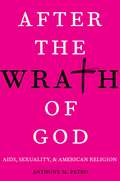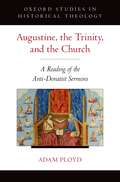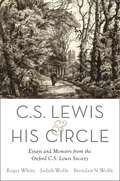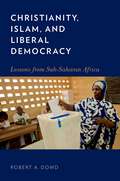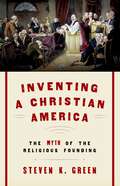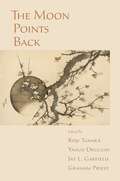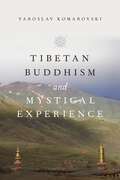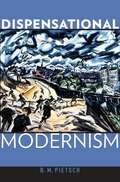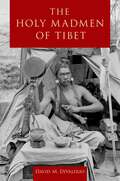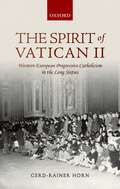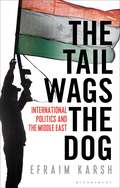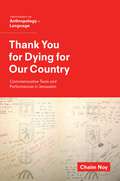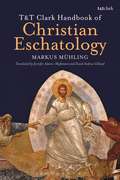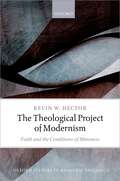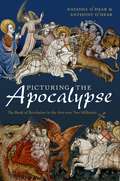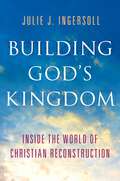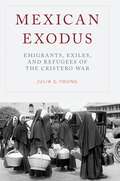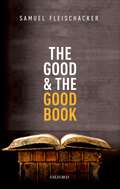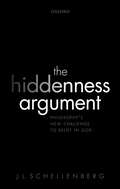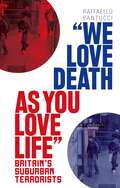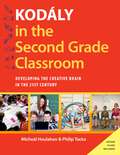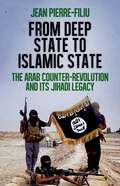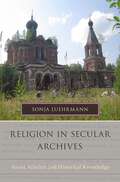- Table View
- List View
After the Wrath of God: AIDS, Sexuality, & American Religion
by Anthony M. PetroOn a cold February morning in 1987, amidst freezing rain and driving winds, a group of protesters stood outside of the Unitarian Universalist Church in Amherst, Massachusetts. The target of their protest was the minister inside, who was handing out condoms to his congregation while delivering a sermon about AIDS, dramatizing the need for the church to confront the seemingly ever-expanding crisis. The minister's words and actions were met with a standing ovation from the overflowing audience, but he could not linger to enjoy their applause. Having received threats in advance of the service, he dashed out of the sanctuary immediately upon finishing his sermon. Such was the climate for religious AIDS activism in the 1980s. In After the Wrath of God, Anthony Petro vividly narrates the religious history of AIDS in America. Delving into the culture wars over sex, morality, and the future of the American nation, he demonstrates how religious leaders and AIDS activists have shaped debates over sexual morality and public health from the 1980s to the present day. While most attention to religion and AIDS foregrounds the role of the Religious Right, Petro takes a much broader view, encompassing the range of mainline Protestant, evangelical, and Catholic groups--alongside AIDS activist organizations--that shaped public discussions of AIDS prevention and care in the U.S. Petro analyzes how the AIDS crisis prompted American Christians across denominations and political persuasions to speak publicly about sexuality--especially homosexuality--and to foster a moral discourse on sex that spoke not only to personal concerns but to anxieties about the health of the nation. He reveals how the epidemic increased efforts to advance a moral agenda regarding the health benefits of abstinence and monogamy, a legacy glimpsed as much in the traction gained by abstinence education campaigns as in the more recent cultural purchase of gay marriage. The first book to detail the history of religion and the AIDS epidemic in the U.S., After the Wrath of God is essential reading for anyone concerned with the intersection of religion and public health.
Augustine, the Trinity, and the Church: A Reading of the Anti-Donatist Sermons (Oxford Studies in Historical Theology)
by Adam PloydThe legacy of Augustine of Hippo (354-430) continues to shape Western Christian language about both the Trinity and the Church, yet scholars rarely treat these two topics as related in his work. In Augustine, the Trinity, and the Church, Adam Ployd argues that Augustine's ecclesiology drew upon his Trinitarian theology to a surprising degree; this connection appears most clearly in a series of sermons Augustine preached in 406-407 against the Donatists, the rival Christian communion in North Africa. As he preached, Augustine deployed scriptural interpretations derived from his Latin pro-Nicene predecessors - but he adapted these Trinitarian arguments to construct a vision of the charitable unity of the Catholic Church against the Donatists. To condemn the Donatists for separating from the body of Christ, for example, Augustine appropriated a pro-Nicene Christology that viewed Christ's body as the means for ascent to his divinity. Augustine also further identified the love that unites Christians to each other and to Christ in his body as the Holy Spirit, who gives to us what he eternally is as the mutual love of Father and Son. On the central issue of baptism, Augustine made the sacrament a Trinitarian act as Christ gives the Spirit to his own body. The book ultimately shows that, for Augustine, the unity and integrity of the Church depended not upon the purity of the bishops or the guarded boundaries of the community, but upon the work of the triune God who unites us to Christ through the love of the Spirit, whom Christ himself gives in baptism.
C. S. Lewis and His Circle: Essays and Memoirs from the Oxford C.S. Lewis Society
by Roger White Judith Wolfe Brendan WolfeFor over thirty years, the Oxford C. S. Lewis Society has met weekly in the medieval colleges of the University of Oxford. During that time, it has hosted as speakers nearly all those still living who were associated with the Inklings-the Oxford literary circle led by C. S. Lewis--as well as authors and thinkers of a prominence that nears Lewis's own. C. S. Lewis and His Circle offers the reader a chance to join this unique group. Roger White has worked with Society past presidents Brendan and Judith Wolfe to select the most important talks, which are here made available to the wider public for the first time. They exemplify the best of traditional academic essays, thoughtful memoirs, and informal reminiscences about C. S. Lewis and his circle. The reader will reimagine Lewis's Cosmic Trilogy with former Archbishop of Canterbury Rowan Williams, read philosopher Elizabeth Anscombe's final word on Lewis's arguments for Christianity, hear the Reverend Peter Bide's memories of marrying Lewis and Joy Davidman in an Oxford hospital, and learn about Lewis's Narnia Chronicles from his former secretary. Representing the finest of both personal and scholarly engagement with C. S. Lewis and the Inklings, the talks collected here set a new tone for engagement with this iconic Oxford literary circle--a tone close to Lewis's own Oxford--bred sharpness and wryness, seasoned with good humor and genuine affection for C. S. Lewis and his circle.
The Catholic Church and Argentina's Dirty War
by Gustavo MorelloOn August 3rd, 1976, in Córdoba, Argentina's second largest city, Fr. James Week and five seminarians from the Missionaries of La Salette were kidnapped. A mob burst into the house they shared, claiming to be police looking for "subversive fighters." The seminarians were jailed and tortured for two months before eventually being exiled to the United States. The perpetrators were part of the Argentine military government that took power under President General Jorge Videla in 1976, ostensibly to fight Communism in the name of Christian Civilization. Videla claimed to lead a Catholic government, yet the government killed and persecuted many Catholics as part of Argentina's infamous Dirty War. Critics claim that the Church did nothing to alleviate the situation, even serving as an accomplice to the dictators. Leaders of the Church have claimed they did not fully know what was going on, and that they tried to help when they could. Gustavo Morello draws on interviews with victims of forced disappearance, documents from the state and the Church, field observation, and participant observation in order to provide a deeper view of the relationship between Catholicism and state terrorism during Argentina's Dirty War. Morello uses the case of the seminarians to explore the complex relationship between Catholic faith and political violence during the Dirty War-a relationship that has received renewed attention since Argentina's own Jorge Mario Bergoglio became Pope Francis. Unlike in countries such as Chile and Brazil, Argentina's political violence was seen as an acceptable tool in propagating political involvement; both the guerrillas and the military government were able to gain popular support. Morello examines how the Argentine government deployed a discourse of Catholicism to justify the violence that it imposed on Catholics and how the official Catholic hierarchy in Argentina rationalized their silence in the face of this violence. Most interestingly, Morello investigates how Catholic victims of state violence and their supporters understood their own faith in this complicated context: what it meant to be Catholic under Argentina's dictatorship.
Christianity, Islam, and Liberal Democracy: Lessons from Sub-Saharan Africa
by Robert A. DowdDrawing from research conducted in Nigeria, Senegal, and Uganda, Christianity, Islam, and Liberal Democracy offers a deeper understanding of how Christian and Islamic faith communities affect the political attitudes of those who belong to them and, in turn, prospects for liberal democracy. While many analysts believe that religious diversity in developing countries is an impediment to liberal democracy, Robert A. Dowd concludes just the opposite. Dowd draws on narrative accounts, in-depth interviews, and large-scale surveys to show that Christian and Islamic religious communities are more likely to support liberal democracy in religiously diverse and integrated settings than in religiously homogeneous or segregated ones. Religious diversity and integration, in other words, are good for liberal democracy. In religiously diverse and integrated environments, religious leaders tend to be more encouraging of civic engagement, democracy, and religious liberty. By providing a theoretical framework for understanding when and where Christian and Islamic communities in sub -Saharan Africa encourage and discourage liberal democracy, Dowd demonstrates how religious communities are important in affecting political actions and attitudes. This evidence, the book ultimately argues, should prompt policymakers interested in cultivating religiously-inspired support for liberal democracy to aid in the formation of religiously diverse neighborhoods, cities, and political organizations.
Contemporary Pagan and Native Faith Movements in Europe: Colonialist and Nationalist Impulses (EASA Series #26)
by Kathryn RountreePagan and Native Faith movements have sprung up across Europe in recent decades, yet little has been published about them compared with their British and American counterparts. Though all such movements valorize human relationships with nature and embrace polytheistic cosmologies, practitioners’ beliefs, practices, goals, and agendas are diverse. Often side by side are groups trying to reconstruct ancient religions motivated by ethnonationalism—especially in post-Soviet societies—and others attracted by imported traditions, such as Wicca, Druidry, Goddess Spirituality, and Core Shamanism. Drawing on ethnographic cases, contributors explore the interplay of neo-nationalistic and neo-colonialist impulses in contemporary Paganism, showing how these impulses play out, intersect, collide, and transform.
Inventing a Christian America: The Myth of the Religious Founding
by Steven K. GreenAmong the most enduring themes in American history is the idea that the United States was founded as a Christian nation. A pervasive narrative in everything from school textbooks to political commentary, it is central to the way in which many Americans perceive the historical legacy of their nation. Yet, as Steven K. Green shows in this illuminating new book, it is little more than a myth. In Inventing a Christian America, Green, a leading historian of religion and politics, explores the historical record that is purported to support the popular belief in America's religious founding and status as a Christian nation. He demonstrates that, like all myths, these claims are based on historical "facts" that have been colored by the interpretive narratives that have been imposed upon them. In tracing the evolution of these claims and the evidence levied in support of them from the founding of the New England colonies, through the American Revolution, and to the present day, he investigates how they became leading narratives in the country's collective identity. Three critical moments in American history shaped and continue to drive the myth of a Christian America: the Puritan founding of New England, the American Revolution and the forging of a new nation, and the early years of the nineteenth century, when a second generation of Americans sought to redefine and reconcile the memory of the founding to match their religious and patriotic aspirations. Seeking to shed light not only on the veracity of these ideas but on the reasons they endure, Green ultimately shows that the notion of America's religious founding is a myth not merely in the colloquial sense, but also in a deeper sense, as a shared story that gives deeper meaning to our collective national identity. Offering a fresh look at one of the most common and contested claims in American history, Inventing a Christian America is an enlightening read for anyone interested in the story of-and the debate over-America's founding.
The Moon Points Back
The Moon Points Back comprises essays by both established scholars in Buddhist and Western philosophy and young scholars contributing to cross-cultural philosophy. It continues the program of Pointing at the Moon (Oxford University Press, 2009), integrating the approaches and insights of contemporary logic and analytic philosophy along with those of Buddhist Studies in order to engage with Buddhist ideas in a contemporary voice. The essays in the volume focus on the Buddhist notion of emptiness (sunyata), exploring its relationship to core philosophical issues concerning the self, the nature of reality, logic, and epistemology. The volume closes with reflections on methodological issues raised by bringing together traditional Buddhist philosophy and contemporary analytic philosophy. The Moon Points Back demonstrates convincingly that integration of Buddhist philosophy with contemporary analytic philosophy and logic allows for novel understandings of and insights into Buddhist philosophical thought. It also shows how Buddhist philosophers can contribute to debates in contemporary Western philosophy and how contemporary philosophers and logicians can engage with Buddhist material.
Tibetan Buddhism and Mystical Experience
by Yaroslav KomarovskiIn this book, Yaroslav Komarovski argues that the Tibetan Buddhist interpretations of the realization of ultimate reality both contribute to and challenge contemporary interpretations of unmediated mystical experience. The model used by the majority of Tibetan Buddhist thinkers states that the realization of ultimate reality, while unmediated during its actual occurrence, is necessarily filtered and mediated by the conditioning contemplative processes leading to it, and Komarovski argues that therefore, in order to understand this mystical experience, one must focus on these processes, rather than on the experience itself. Komarovski also provides an in-depth comparison of seminal Tibetan Geluk thinker Tsongkhapa and his major Sakya critic Gorampa's accounts of the realization of ultimate reality, demonstrating that the differences between these two interpretations lie primarily in their conflicting descriptions of the compatible conditioning processes that lead to this realization. Komarovski maintains that Tsongkhapa and Gorampa's views are virtually irreconcilable, but demonstrates that the differing processes outlined by these two thinkers are equally effective in terms of actually attaining the realization of ultimate reality. Tibetan Buddhism and Mystical Experience speaks to the plurality of mystical experience, perhaps even suggesting that the diversity of mystical experience is one of its primary features.
Dispensational Modernism
by B. M. PietschDispensationalism emerged in the twentieth century as a hugely influential force in American religion and soon became one of America's most significant religious exports. By the close of the century it had developed into a global religious phenomenon claiming millions of adherents. As the most common form of contemporary prophecy belief, dispensationalism has played a major role in transforming religion, politics, and pop culture in the U.S. and throughout the world. Despite its importance and continuing appeal, scholars often reduce dispensationalism to an anti-modern, apocalyptic, and literalist branch of Protestant fundamentalism. In Dispensational Modernism, B. M. Pietsch argues that, on the contrary, the allure of dispensational thinking can best be understood through the lens of technological modernism. Pietsch shows that between 1870 and 1920 dispensationalism grew out of the popular fascination with applying engineering methods -- such as quantification and classification -- to the interpretation of texts and time. At the heart of this new network of texts, scholars, institutions, and practices was the lightning-rod Bible teacher C. I. Scofield, whose best-selling Scofield Reference Bible became the canonical formulation of dispensational thought. The first book to contextualize dispensationalism in this provocative way, Dispensational Modernism shows how mainstream Protestant clergy of this time developed new "scientific" methods for interpreting the Bible, and thus new grounds for confidence in religious understandings of time itself.
The Holy Madmen of Tibet
by David M. DiValerioThroughout the past millennium, certain Tibetan Buddhist yogins have taken on profoundly norm-overturning modes of dress and behavior, including draping themselves in human remains, consuming filth, provoking others to violence, and even performing sacrilege. They became known far and wide as "madmen" (smyon pa, pronounced nyönpa), achieving a degree of saintliness in the process. This book offers the first comprehensive study of Tibet's "holy madmen" drawing on their biographies and writings, as well as tantric commentaries, later histories, oral traditions, and more. Much of The Holy Madmen of Tibet is dedicated to examining the lives and legacies of the three most famous "holy madmen" who were all of the Kagyü sect: the Madman of Tsang (author of The Life of Milarepa), the Madman of Ü, and Drukpa Künlé, Madman of the Drukpa Kagyü. Each born in the 1450s, they rose to prominence during a period of civil war and of great shifts in Tibet's religious culture. By focusing on literature written by and about the "holy madmen" and on the yogins' relationships with their public, this book offers in-depth looks at the narrative and social processes out of which sainthood arises, and at the role biographical literature can play in the formation of sectarian identities. By showing how understandings of the "madmen" have changed over time, this study allows for new insights into current notions of "crazy wisdom." In the end, the "holy madmen" are seen as self-aware and purposeful individuals who were anything but insane.
The Spirit of Vatican II: Western European Progressive Catholicism in the Long Sixties
by Gerd-Rainer HornVatican II profoundly changed the outlook and the message of the Catholic Church. After decades, if not centuries, in which Catholic public opinion appeared to be primarily oriented towards the distant past and bygone societal models, suddenly the Catholic Church embraced the world as it was, and it joined in the struggle to create a radiant future. The Sixties were a time of great socio-cultural and political ferment in Europe as a whole. Especially the second half of the 1960s and the first half of the 1970s witnessed an astounding range of 'new' and 'old' social movements reaching for the sky. Catholic activists provided fuel to the fire in more ways than one. Catholics had embarked on the quest for new horizons for some years prior to the sudden growth of secular activism in and around the magic year of 1968. When secular radicals joined up with Catholic activists, a seemingly unstoppable dynamic was unleashed. This book covers five crucial contributions by Catholic communities to the burgeoning atmosphere of those turbulent years: a) the theological innovations of Vatican II, which made such an unprecedented engagement of Catholics possible in the first place, but also post-conciliar theological developments; b) the resurgence of the worker priest experiment, and the first-ever creation of autonomous organisations of radical parish priests; c) the simultaneous creation of grassroots organisations - base communities - by (mostly) lay activists across the continent; d) the crucial roles of Catholic students in the multiform student movements shaping Europe in these years; e) the indispensable contributions of Catholic workers who helped shape - and often initiated - the wave of militant contestations shaking up labour relations after 1968.
The Tail Wags the Dog: International Politics and the Middle East
by Efraim KarshThe continuing crisis in Syria has raised a question mark over the common perception of Middle Eastern affairs as an offshoot of global power politics. To western intellectuals, foreign policy experts and politicians, 'empire' and 'imperialism' are categories that apply exclusively to the European powers and more recently to the United States of America. Lacking an internal dynamic of its own, the view of such people is that Middle Eastern history is the product of its unhappy interaction with the West. This is the basis of Obama`s much ballyhooed `new beginning between the United States and Muslims around the world`.Efraim Karsh propounds in these pages a radically different interpretation of Middle Eastern experience. He argues that the Western view of Muslims and Arabs as hapless victims is absurd. On the contrary modern Middle Eastern history has been the culmination of long existing indigenous trends, passions and patterns of behaviour. Great power influences, however potent, have played a secondary role constituting neither the primary force behind the region`s political development nor the main cause of its notorious volatility.Notwithstanding the Obama administration's abysmal failure to address the momentous Middle Eastern events of recent years, Karsh argues it is only when Middle Eastern people disown their victimization mentality and take responsibility for their actions and their western champions drop their condescending approach to Arabs and Muslims, that the region can at long last look forward to a real `spring`.
Thank You for Dying for Our Country: Commemorative Texts and Performances in Jerusalem (Oxf Studies in Anthropology of Language)
by Chaim NoyCombining ethnographic, semiotic, and performative approaches, this book examines texts and accompanying acts of writing of national commemoration. The commemorative visitor book is viewed as a mobilized stage, a communication medium, where visitors' public performances are presented, and where acts of participation are authored and composed. The study contextualizes the visitor book within the material and ideological environment where it is positioned and where it functions. The semiotics of commemoration are mirrored in the visitor book, which functions as a participatory platform that becomes an extension of the commemorative spaces in the museum. The study addresses tourists' and visitors' texts, i.e. the commemorative entries in the book, which are succinct dialogical utterances. Through these public performances, individuals and groups of visitors align and affiliate with a larger imagined national community. Reading the entries allows a unique perspective on communication practices and processes, and vividly illustrates such concepts as genre, voice, addressivity, indexicality, and the very acts of writing and reading. The book's many entries tell stories of affirming, but also resisting the narrative tenets of Zionist national identity, and they illustrate the politics of gender and ethnicity in Israel society. The book presents many ethnographic observations and interviews, which were done both with the management of the site (Ammunition Hill National Memorial Site), and with the visitors themselves. The observations shed light on processes and practices involved in writing and reading, and on how visitors decide on what to write and how they collaborate on drafting their entries. The interviews with the site's management also illuminate the commemoration projects, and how museums and exhibitions are staged and managed.
T&T Clark Handbook of Christian Eschatology
by Markus MühlingThis textbook offers a systematic introduction to eschatology. The first part introduces the historical approaches to eschatology. The second part concerns the reasons for eschatological statements in light of important aspects of the doctrine of God and Christ. The third part is devoted to different concepts of the relationship between eternity and time, space and infinitude as well as the question of what is good, true and beautiful. Using a thematic structure, the multiple different approaches and concepts of modern eschatology are clearly presented, and illuminated by the perspective of the classical teachings on the Last Things; which are ultimately brought together in a synthesis. This is an important contribution to a crucial part of the study of systematic theology.
The Theological Project of Modernism: Faith and the Conditions of Mineness (Oxford Studies In Analytic Theology)
by Kevin W. HectorModernism's theological project was an attempt to explain two things: firstly, how faith might enable persons to experience their lives as hanging together, even in the face of disintegrating forces like injustice, tragedy, and luck; and secondly, how one could see such faith, and so a life held together by it, as self-expressive. Modern theologians such as Kant, Schleiermacher, Hegel, Ritschl, and Tillich thus offer accounts of how one's life would have to hang together such that one could identify with it; of the oppositions which stand in the way of such hanging-together; of God as the one by whom oppositions are overcome, such that one can have faith that one's life ultimately hangs together; and of what such faith would have to be like in order for one to identify with it, too. So understood, modern theology not only sheds light on faith's potential role in enabling persons to identify with their lives, but stands in unexpected continuity with contemporary 'contextual' theologies. This book offers clear, careful readings of modernism's key figures in order to explain their relevance to practical concerns and to contemporary understandings of faith.
Picturing the Apocalypse: The Book of Revelation in the Arts over Two Millennia
by Natasha O'Hear Anthony O'HearThe book of Revelation has been a source of continual fascination for nearly two thousand years. Concepts such as The Lamb of God, the Four Horsemen, the Seventh Seal, the Beasts and Antichrist, the Whore of Babylon, Armageddon, the Millennium, the Last Judgement, the New Jerusalem, and the ubiquitous Angel of the Apocalypse have captured the popular imagination. One can hardly open a newspaper or click on a news web site without reading about impending financial or climate change Armageddon, while the concept of the Four Horsemen pervades popular music, gaming, and satire. Yet few people know much about either the basic meaning or original context of these concepts or the multiplicity of different ways in which they have been interpreted by visual artists in particular. The visual history of this most widely illustrated of all the biblical books deserves greater attention. This book fills these gaps in a striking and original way by means of ten concise thematic chapters which explain the origins of these concepts from the book of Revelation in an accessible way. These explanations are augmented and developed via a carefully selected sample of the ways in which the concepts have been treated by artists through the centuries. The 120 visual examples are drawn from a wide range of time periods and media including the ninth-century Trier Apocalypse, thirteenth-century Anglo-Norman Apocalypse Manuscripts such as the Lambeth and Trinity Apocalypses, the fourteenth-century Angers Apocalypse Tapestry, fifteenth-century Apocalypse altarpieces by Van Eyck and Memling, Dürer and Cranach's sixteenth-century Apocalypse woodcuts, and more recently a range of works by William Blake, J. M. W. Turner, Max Beckmann, as well as film posters and stills, cartoons, and children's book illustrations. The final chapter demonstrates the continuing resonance of all the themes in contemporary religious, political, and popular thinking, while throughout the book a contrast will be drawn between those readers of Revelation who have seen it in terms of earthly revolutions in the here and now, and those who have adopted a more spiritual, otherworldly approach.
Building God's Kingdom: Inside the World of Christian Reconstruction
by Julie J. IngersollFor the last several decades, at the far fringes of American evangelical Christianity has stood an intellectual movement known as Christian Reconstruction. The proponents of this movement embrace a radical position: that all of life should be brought under the authority of biblical law as it is contained in both the Old and New Testaments. They challenge the legitimacy of democracy, argue that slavery is biblically justifiable, and support the death penalty for all manner of "crimes" described in the Bible including homosexuality, adultery, and Sabbath-breaking. But, as Julie Ingersoll shows in this fascinating new book, this "Biblical Worldview" shapes their views not only on political issues, but on everything from private property and economic policy to history and literature. Holding that the Bible provides a coherent, internally consistent, and all-encompassing worldview, they seek to remake the entirety of society--church, state, family, economy--along biblical lines. Tracing the movement from its mid-twentieth-century origins in the writings of theologian and philosopher R.J. Rushdoony to its present-day sites of influence, including the Christian Home School movement, advocacy for the teaching of creationism, and the development and rise of the Tea Party, Ingersoll illustrates how Reconstructionists have broadly and subtly shaped conservative American Protestantism over the course of the late-twentieth and early-twenty-first centuries. Drawing on interviews with Reconstructionists themselves as well as extensive research in Reconstructionist publications, Building God's Kingdom offers the most complete and balanced portrait to date of this enigmatic segment of the Christian Right.
Mexican Exodus: Emigrants, Exiles, and Refugees of the Cristero War
by Julia G. YoungIn the summer of 1926, an army of Mexican Catholics launched a war against their government. Bearing aloft the banners of Christ the King and the Virgin of Guadalupe, they equipped themselves not only with guns, but also with scapulars, rosaries, prayers, and religious visions. These soldiers were called cristeros, and the war they fought, which would continue until the mid-1930s, is known as la Cristiada, or the Cristero war. The most intense fighting occurred in Mexico's west-central states, especially Jalisco, Guanajuato, and Michoacán. For this reason, scholars have generally regarded the war as a regional event, albeit one with national implications. Yet in fact, the Cristero war crossed the border into the United States, along with thousands of Mexican emigrants, exiles, and refugees. In Mexican Exodus, Julia Young reframes the Cristero war as a transnational conflict, using previously unexamined archival materials from both Mexico and the United States to investigate the intersections between Mexico's Cristero War and Mexican migration to the United States during the late 1920s. She traces the formation, actions, and ideologies of the Cristero diaspora--a network of Mexicans across the United States who supported the Catholic uprising from beyond the border. These Cristero supporters participated in the conflict in a variety of ways: they took part in religious ceremonies and spectacles, organized political demonstrations and marches, formed associations and organizations, and collaborated with religious and political leaders on both sides of the border. Some of them even launched militant efforts that included arms smuggling, military recruitment, espionage, and armed border revolts. Ultimately, the Cristero diaspora aimed to overturn Mexico's anticlerical government and reform the Mexican Constitution of 1917. Although the group was unable to achieve its political goals, Young argues that these emigrants--and the war itself--would have a profound and enduring resonance for Mexican emigrants, impacting community formation, political affiliations, and religious devotion throughout subsequent decades and up to the present day.
The Good and the Good Book: Revelation as a Guide to Life
by Samuel Fleischacker'It is written ...,' says the believer in a sacred text, and proceeds to justify all manner of terrifying things. Or so runs a popular caricature of religious faith today. Religions that center around a revelation—around a 'good book,' like the Torah or Gospels or Quran, which is seen as God's word—are widely regarded as irrational and dangerous: as based on outdated science and conducive to illiberal, inhumane moral attitudes. The Good and the Good Book defends revealed religion and shows how it can be reconciled with science and liberal morality. Samuel Fleischacker invites us to see revealed texts as aiming to teach neither scientific nor moral doctrines but a vision of what life is about overall. Purely naturalistic ways of thinking, he argues, cannot make much sense of our overall or ultimate good; revealed texts, by contrast, do precisely that. But these texts also need to be interpreted so as to accord with our independent understanding of morality. A delicate balance is required for this process of interpretation—between respecting the uncanny obscurity of our sacred texts and rendering them morally familiar. The book concludes with an account of how believers in one religion can respect believers in other religions, and secular people.
The Hiddenness Argument: Philosophy's New Challenge to Belief in God
by J. L. SchellenbergIn many places and times, and for many people, God's existence has been rather less than a clear fact. According to the hiddenness argument, this is actually a reason to suppose that it is not a fact at all. The hiddenness argument is a new argument for atheism that has come to prominence in philosophy over the past two decades. J. L. Schellenberg first developed the argument in 1993, and this book offers a short and vigorous statement of its central claims and ideas. Logically sharp but so clear that anyone can understand, the book addresses little-discussed issues such as why it took so long for hiddenness reasoning to emerge in philosophy, and how the hiddenness problem is distinct from the problem of evil. It concludes with the fascinating thought that retiring the last of the personal gods might leave us nearer the beginning of religion than the end. Though an atheist, Schellenberg writes sensitively and with a nuanced insider's grasp of the religious life. Pertinent aspects of his experience as a believer and as a nonbeliever, and of his own engagement with hiddenness issues, are included. Set in this personal context, and against an authoritative background on relevant logical, conceptual, and historical matters, The Hiddenness Argument's careful but provocative reasoning makes crystal clear just what this new argument is and why it matters.
"We Love Death As You Love Life": Britain's Suburban Terrorists
by Raffaello PantucciAs Mohammed Siddique Khan led his group of fellow-believers into London on the morning of July 7, 2005 it is unlikely that they were thinking much beyond the immediate impact of their actions. Driven by anger at the West's treatment of Muslims worldwide, ideas fed to them by foreign extremists, and a sense of extreme rejection of the society in which they were born, they sought to reshape the world in an image they thought would be pleasing to God. But while they felt they were on a holy mission -- as enunciated in Khan's chilling video message, We Love Death As You Love Life-- a far more earthly arc of history underlay their actions. This book offers an insight into the motivations behind Khan and his group, as well as the hundreds of young British Muslims who have been drawn by jihadist ideas to fight on battlefields at home and abroad. Starting with the arrival of immigrant communities to the UK and the establishment of diasporas with strong ethnic connections to the Middle East and South Asia, to the arrival of jihadist warriors fresh from the anti-Soviet war Afghanistan, this book looks at the history that came before Mohammed Siddique Khan and places his action within its larger context. This book provides the first comprehensive history of jihadist ideas and violence in the United Kingdom.
Kodály in the Second Grade Classroom: Developing the Creative Brain in the 21st Century (Kodaly Today Handbook Series)
by Micheal Houlahan Philip TackaSince the mid-twentieth century, Zoltán Kodály's child-developmental philosophy for teaching music has had significant positive impact on music education around the world, and is now at the core of music teaching in the United States and other English speaking countries. The Kodály Today handbook series is the first comprehensive system to update and apply the Kodály concepts to teaching music in elementary school classrooms. Kodály in the Second Grade Classroom provides teachers with a step-by-step road map for developing children's performance, creative movement, and literacy skills in an organic and thoughtful manner. Through six years of field-testing with music kindergarten teachers in the United States, Great Britain, and Hungary (the home country of Zoltán Kodály), authors Micheál Houlahan and Philip Tacka have developed a methodology specifically for 21st century classrooms. Houlahan and Tacka use the latest research findings in cognition and perception to create a system not only appropriate for the developmental stages of second grade students but also one which integrates vertically between elementary music classes. The methods outlined in this volume encourage greater musical ability and creativity in children by teaching them to sing, move, play instruments, and develop music literacy skills. In addition, Kodály in the Second Grade Classroom promotes critical thinking, problem solving, and collaboration skills. Although the book uses the Kodály philosophy, its methodology has also been tested by teachers certified in Orff and Dalcroze, and has proven an essential guide for teachers no matter what their personal philosophy and specific training might be. Numerous children's songs are incorporated into Kodály in the Second Grade Classroom, as well as over 35 detailed lesson plans that demonstrate how music and literacy curriculum goals are transformed into tangible musical objectives. Scholarly yet practical and accessible, this volume is sure to be an essential guide for kindergarten and early childhood music teachers everywhere.
From Deep State to Islamic State: The Arab Counter-Revolution and its Jihadi Legacy
by Jean-Pierre FiliuIn his disturbing and timely book Jean-Pierre Filiu lays bare the strategies and tactics employed by the Middle Eastern autocracies, above all those of Syria, Egypt, Yemen and Algeria, that set out to crush the democratic uprisings of the 'Arab Revolution.' In pursuit of these goals they turned to the intelligence agencies and internal security arms of the 'deep state,' the armed forces, and to street gangs such as the Shabiha to enforce their will. Alongside physical intimidation, imprisonment and murder, Arab counter-revolutionaries discredited and split their opponents by boosting Salafi-Jihadi groups such as Islamic State. They also released from prison hardline Islamists and secretly armed and funded them. The full potential of the Arab counter-revolution surprised most observers, who thought they had seen it all from the Arab despots: their perversity, their brutality, their voracity. But the wider world underestimated their ferocious readiness literally to burn down their countries in order to cling to absolute power. Bashar al-Assad clambered to the top of this murderous class of tyrants, driving nearly half of the Syrian population in to exile and executing tens of thousands of his opponents. He has set a grisly precedent, one that other Arab autocrats are sure to follow in their pursuit of absolute power.
Religion in Secular Archives: Soviet Atheism and Historical Knowledge (Oxford Series on History and Archives)
by Sonja LuehrmannWhat can atheists tell us about religious life? Russian archives contain a wealth of information on religiosity during the Soviet era, but most of it is written from the hostile perspective of officials and scholars charged with promoting atheism. Based on archival research in locations as diverse as the multi-religious Volga region, Moscow, and Texas, Sonja Luehrmann argues that we can learn a great deal about Soviet religiosity when we focus not just on what documents say but also on what they did. Especially during the post-war decades (1950s-1970s), the puzzle of religious persistence under socialism challenged atheists to develop new approaches to studying and theorizing religion while also trying to control it. Taking into account the logic of filing systems as well as the content of documents, the book shows how documentary action made religious believers firmly a part of Soviet society while simultaneously casting them as ideologically alien. When juxtaposed with oral, printed, and samizdat sources, the records of institutions such as the Council of Religious Affairs and the Communist Party take on a dialogical quality. In distanced and carefully circumscribed form, they preserve traces of encounters with religious believers. By contrast, collections compiled by western supporters during the Cold War sometimes lack this ideological friction, recruiting Soviet believers into a deceptively simple binary of religion versus communism. Through careful readings and comparisons of different documentary genres and depositories, this book opens up a difficult set of sources to students of religion and secularism.
